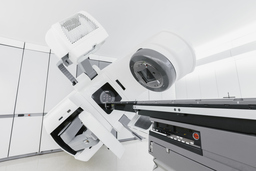Combined Radiation Acoustics and Ultrasound for Radiotherapy Guidance and Cancer Targeting
TECHNOLOGY NUMBER: 2018-310

OVERVIEW
A radiotherapy dose measurement method using combined radiation and acoustic imaging- Permits anatomical and functional imaging during a radiotherapy treatment
- Allows improved dose delivery to tumor targets relative to adjacent normal tissues
BACKGROUND
Radiotherapy (RT) is recognized to be a highly conformal and effective treatment for many types of cancers and is the primary treatment modality for many locally advanced cancers. Radiation dose planning, quality assurance, and delivery methods have improved dramatically in recent years. Clinical dose measurement, or dosimetry, may involve the use of ion chambers, diodes, thermal dosimeters, or any one of several other methods. However, in spite of meticulous off-line treatment planning processes and the use of imaging during therapy to provide quality assurance, current dose delivery methods are limited due to geometric uncertainties caused by target deformations, organ motion, or function. Discrepancies can therefore be observed between planned and delivered radiation treatments, which reduces the amount of radiation delivered to the tumor and undesirably increases the radiation delivered to healthy or normal tissues. A need therefore exists for a method by which to provide a means for radiotherapy dosimetry whose results are volumetric, real-time, and independent of dose rate or energy.
INNOVATION
Researchers at the University of Michigan have invented a method and system for performing online adaptive radiotherapy using combined ultrasound and ionizing radiation induced acoustic imaging (iRAI) computed tomography imaging techniques. The device measures low to ultrahigh dose deliveries, and it allows for anatomical and functional imaging while measuring radiation doses given in real time to an area of interest during a radiotherapy session. This technology can therefore more easily track tumors and direct the delivery of radiation to the tumor site. The retrieved data can provide information which permits corrections to radiation dosage and locations between, or even during, radiotherapy treatments. The advantage of this approach is an improvement in the ratio of dosing delivered to the tumor versus the normal adjacent structures. This X-ray-induced acoustic computed tomography (XACT) model will be useful in the clinical setting for measuring absolute, relative, and in vivo dosimetry.